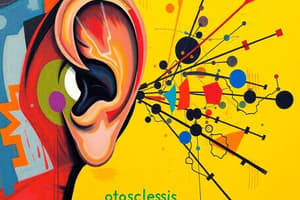Podcast
Questions and Answers
What is the most common cause of hearing loss in young adults?
What is the most common cause of hearing loss in young adults?
- Ménière's disease
- Otosclerosis (correct)
- Presbycusis
- Noise-induced hearing loss
Which of the following is NOT a characteristic of otosclerosis?
Which of the following is NOT a characteristic of otosclerosis?
- Reddish blush of the TM (Schwartz sign)
- Sensorineural hearing loss (correct)
- Bilateral involvement
- Conductive hearing loss
What is the typical difference in decibels between air and bone conduction levels of hearing in a patient with otosclerosis?
What is the typical difference in decibels between air and bone conduction levels of hearing in a patient with otosclerosis?
- 20-25 dB (correct)
- 15-20 dB
- 30-35 dB
- 5-10 dB
What is the mechanism by which otosclerosis causes hearing loss?
What is the mechanism by which otosclerosis causes hearing loss?
What is the genetic inheritance pattern of otosclerosis?
What is the genetic inheritance pattern of otosclerosis?
Flashcards
Otosclerosis
Otosclerosis
A hereditary condition causing hearing loss due to abnormal bone growth in the middle ear.
Conductive hearing loss
Conductive hearing loss
Hearing loss due to problems transmitting sound to the inner ear; common with otosclerosis.
Schwartz sign
Schwartz sign
A reddish blush of the tympanic membrane seen in otosclerosis, indicating vascular changes.
Air-bone gap
Air-bone gap
Signup and view all the flashcards
Tuning fork tests
Tuning fork tests
Signup and view all the flashcards
Study Notes
Otosclerosis Overview
- Otosclerosis is a hereditary autosomal dominant disease.
- It's the most common cause of hearing loss in young adults.
- Spongy bone growth within the bony labyrinth affects the stapes footplate.
- This prevents vibration transmission to inner ear fluids.
- This results in conductive hearing loss.
- Otosclerosis is typically bilateral, but one ear may progress faster.
- Patients are often unaware of the issue until the hearing loss significantly impacts communication.
Diagnostic Features
- Otoscopic Examination: May reveal a reddish blush on the tympanic membrane (Schwartz sign).
- Cause of Schwartz Sign: Vascular and bony changes in the middle ear.
- Tuning Fork Tests (e.g., Rinne): Reveal good bone conduction and poor air conduction (air-bone gap).
- Audiogram: Shows a significant difference (at least 20-25 dB) between air and bone conduction hearing levels (air-bone gap).
Studying That Suits You
Use AI to generate personalized quizzes and flashcards to suit your learning preferences.




